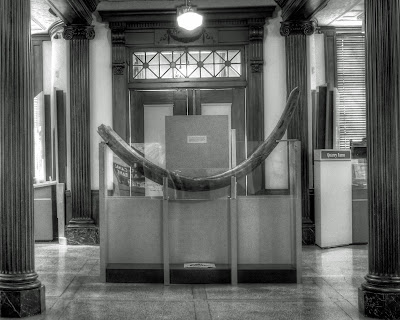By Erin Doane, Senior Curator
On November 7, 1923, the Elmira chapter of the Sons of the American Revolution held a meeting. At that meeting, the organization’s president Dr. Arthur W. Booth proposed the creation of a historical society to preserve historic objects, documents, and stories. The first official meeting of the Chemung County Historical Society took place two weeks later with 75 people in attendance.
The Historical Society’s first home was in two rooms on the upper floor of the Steele Memorial Library on the corner of Lake and Church Streets (now the Chemung County Chamber of Commerce). The rooms quickly filled with donations from the community. Members of the society presented talks about local history and created displays of historic objects in the library for the public to enjoy.
The Historical Society received its charter from
New York State in 1947. Shortly after, they began searching for a stand-alone
building to house the collections and provide more space for displays. In 1953,
the Historical Society moved into 425 East Market Street and Frances Brayton
was appointed as its first professional curator.

Chemung County Historian Clark Wilcox stands in one of the
Historical Society’s rooms in the Steele Memorial Library, 1947
 |
| The Chemung County Historical Center on Market Street, 1950s |
 |
| Mammoth tusk on display at the Historical Society, 1950s |
 |
| The Chemung County Historical Center on William Street, 1976 |
The mammoth tusk and all the other historic objects, documents, and photographs that had been donated over the previous 40+ years were moved into their new home. Many of the objects were used in new exhibits focused on topics we still explore in the museum today - life here in the 1800s, the Civil War, local organizations and schools, and, of course, Mark Twain. Materials that didn’t go on display went into storage. Unfortunately, one of the main storage spaces in the building was the basement, which proved disastrous during the 1972 Flood. (click here to read how the Historical Society reacted to the flooding)
 |
| The mammoth tusk on display on William Street, 1976 |
The Chemung County Historical Society moved one more time to its current location at 415 E. Water Street. The building was originally home to the Chemung Canal Bank starting in 1833. After the bank moved into new headquarters, the building housed law offices and apartments. It underwent major renovations in the late 1970s and opened to the public as the Chemung County Historical Society in 1982. In 1986, the Historical Society received accreditation from the American Alliance of Museums (AAM). It was reaccredited most recently in 2021. Less than 5% of museum in the United States are accredited by the AAM. In 1992, further renovations to the building took place. An addition that includes the Howell Gallery, the Frances Brayton Education Room, and the Barn Gallery, as well as a new entranceway, was added to the main building.
 |
| 415 E. Water Street, late 1970s |
And, yes, the mammoth tusk is still on display.
 |
| The mammoth tusk at E. Water Street, 2014 |
Awesome history. 1923 and still going strong.
ReplyDelete